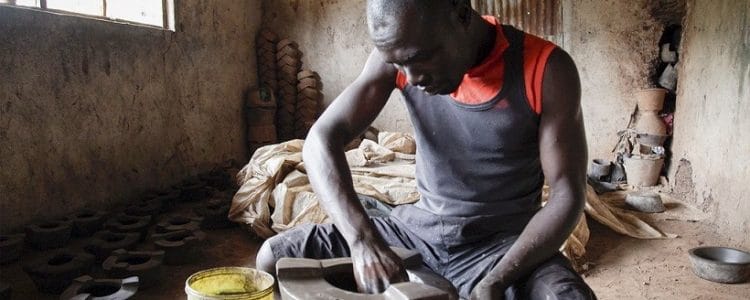
INCLUDE and the Netherlands Ministry of Foreign Affairs will jointly organize a conference on ‘Boosting youth employment in Africa: what works and why?’ on 30 May, in The Hague. In preparation of this conference, the INCLUDE secretariat has drafted a synthesis report, which reviews the state-of-the-art knowledge on youth employment in Africa and which sets out the scope for the conference.
Below you can find the summary. To download the summary and the highlights of the synthesis report (PDF), please click here.
To download the full synthesis report, click here.
Summary
Youth employment is a top priority for African countries. More than 10 million young Africans enter the workforce each year. Most of them work in agriculture; at best, 1 in 4 will find a wage job. For most African youth (aged 15–24 years) the key employment issue is underemployment. They do work, but part-time and in low-skilled jobs in the informal sector, including in subsistence agriculture and urban self-employment. Such employment offers no job security, minimal benefits, low pay, and often unhealthy working conditions. To reach the majority of youth, short- and long-term employment strategies need to take into account the current nature of youth employment across Africa. Where do most young people reside? Where do they, and will they be, working in the coming years? And what are the characteristics and aspirations of youth?
Despite rapid urbanization, the bulk of African youth live in rural areas. In 2010, the majority of the population in Africa worked on a family farm (60%) or in a household enterprise (20%). By 2020, most new jobs will be created in these informal sectors: one-third in agriculture and no less than 45% in household enterprises. In many countries in Sub-Saharan Africa the off-farm food system is growing rapidly and offers significant employment opportunities. However, jobs created in this area will not match those created in agriculture, in absolute terms, for at least the next 10 years. At the same time, wage employment in industry and services remains low: in 2010, the wage sector provided jobs to only 16% of the labour force. By 2020, only 8% of total new jobs will be created in the wage industry sector. Even if the sector grows at the rates experienced in Asia, it will not create sufficient jobs in the next 20 years, as the growth is from a very low base. The wage services sector is expected to do better: by 2020, roughly one-third of all new jobs will be created in this sector. The digital economy also offers opportunities, but here, too, the scale is limited. The digital economy is estimated to provide direct employment for only 1 in every 50 youth entering the labour market. These numbers show that formal wage employment is not an option for many young people. Informal is the norm, and productivity growth in the informal sector is more likely to create employment in the short term than the formal sector.
However, youth are not a homogenous group. Four groups of youth can be distinguished: rural youth from modest farming families working on the family farm; low-skilled, self-employed youth in urban or rural survival enterprises; young apprentices in rural or urban individual enterprises; and 4) young urban graduates seeking formal wage-employment. These different groups face different employment and employability constraints.
Reaching the different types of youth requires a comprehensive approach that combines measures to create employment with measures to ensure that youth have access to jobs. Effective short-term micro-level interventions are those that offer multiple services (training, finance, land, technology and networks), tailored to individual needs (profiling), with long-term mentoring. Effective short-term macro-level interventions are those aimed at enhancing productivity in agriculture (including new opportunities in the off-farm food system) and in informal household enterprises. Local economic conditions determine the (sub) sectors to prioritize. Youth are most likely to gain productive employment when entry barriers are low, demand for the product/services is increasing, and the activities can be performed year round. Continued investment in the creation of wage employment in manufacturing and services is needed to absorb the expanding labour force, but will only yield results in the long term.
Different actors have different roles to play in creating employment opportunities for youth. The private sector creates most new jobs, either through its own businesses or by making impact investments. The private sector can also engage in training programmes to ensure that youth have the skills that the market needs. NGOs often have a comparative advantage in implementing micro-level interventions, as they are close to young people in their communities and can work with local business associations and CBOs. National governments are key actors for promoting enabling business and investment conditions, and coordinating the efforts of various actors. To translate good policies into effective implementation and continuous learning requires political will. Donors have a role to play in supporting and funding youth employment programmes and youth organizations (e.g. farmers’ associations, resource hubs, CBOs). They can also assist in value chain development, both financially and through technology transfers. Financial institutions are crucial funders of programmes aimed at enhancing productivity in agriculture, the off-farm food system, and household enterprises, as well as long-term investments in industrial development. Finally, knowledge institutes can play a vital role in providing governments and development partners with proper diagnoses of youth un- and underemployment challenges and the effectiveness and impact of programmes and interventions.
There is a growing international consensus that a policy shift is needed to create employment for youth in the short term. Tackling un- and underemployment among African youth requires a local focus on multiple interventions that increase productivity in potential growth sectors, as well as tailor-made interventions that equip youth to exploit these opportunities.




